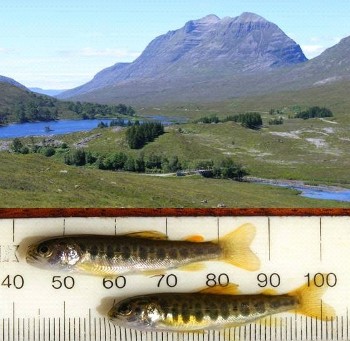2011 WRFT juvenile salmon survey: a mixed picture
Posted: Wednesday 16 November, 2011 @ 13:11:25

Between July and November, WRFT electro-fishing teams led by Peter Cunningham, Jonah Tosney and Roger Mclachlan carried out one of the most comprehensive juvenile fish surveys of the Trust area in recent years. Despite unfavourable conditions for fieldwork with high water levels through much of September and October, data confirming the occurrence or absence of juvenile salmon was collected from most of the main river systems including many important tributaries, as well as many of the smaller stream systems. WRFT surveys were complimented by those of the SEPA electro-fishing teams, led by Ruth Watts and Anthony Watkins.
Healthy populations of juvenile salmon of wild origin were recorded in core areas of most rivers. However, despite finding good numbers of parr at most sites, salmon fry were absent or rare in some headwater streams, for example the upper Kanaird, Allt Beith, Tournaig system, Docherty burn (Ewe system) and Allt Coire Crubaidh (Carron). The scarcity of salmon fry in some areas in 2011 can be explained by unusually severe weather and river conditions during the 2010 spawning season (mid November – December 2010): very low water followed by deep frost. This may have prevented salmon from ascending some of the smaller spawning streams. In contrast, surveys indicated that salmon fry were present throughout the accessible areas of the Gruinard, Little Gruinard (except one minor stream) and Ullapool rivers.
For the second year in succession, water levels in the River Broom remained too high for Ross Gardiner of Marine Scotland Science to carry out his scheduled quantitative survey in August. Nevertheless, salmon fry were found by the WRFT team at two main river sites and in two tributary streams suggesting that the Broom salmon population remains in good health.
Smaller rivers surveyed included the South Erradale burn to the south of Gairloch, and the Sand burn in Laide wood. Both these streams are large enough to support salmon, and there are anecdotal stories of adult salmon being taken in years gone by. However, no juvenile salmon were found in either system; only trout and eels. With community support for restoration programmes focussed on improving habitat and ensuring the survival of any adult fish until they spawn, both these systems could support runs of salmon in addition to sea trout. Further south, salmon fry were found in the Shieldaig River system by the MSS team for the first time in 10 years following the run of 3 adult salmon into the system in 2010.
The 2011 salmon spawning season is imminent in Wester Ross. For the second year in succession water levels are unusually low for November and rain is needed if available spawning habitat is to be fully utilised.
Details and further analyses of WRFT juvenile fish surveys in 2011 will be written up and reported over the coming months. Please contact biologists Peter Cunningham (info@wrft.org.uk) or Jonah Tosney (Jonah.Tosney@inverness.uhi.ac.uk) for further information.